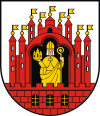
Alternate names: Grudziądz [Pol], Graudenz [Ger], Grudziondz, Grudzëndz, Graudenz [Ger], Graudensis [Latin], Грудзёндз) [Russian] . 53°29' N, 18°46' E, 60 miles S of Gdańsk (Danzig), 39 miles NE of Bydgoszcz (Bromberg), 32 miles NNE of Toruń (Thorn). 1938 Jewish population: 730. A city in northern Poland on the Vistula River with 99,090 inhabitants in 2007. In the Kuyavian-Pomeranian Voivodeship since 1999, the city was previously in Toruń Voivodeship (1975-1998). On September 3, 1939 Nazi troops entered Grudziądz and annexed the city into the Reichsgau Danzig-West Prussia. Graudenz was the location of the German concentration camp Graudenz, a subcamp of Stutthof concentration camp. As the result of heavy fighting in 1945, over 60% of the city was destroyed. video of the city. First Jews arrived to Grudziad in the 19th century. 1939 Jewish population: 182. In 1844, a synagogue was built. The Old Jewish cemetery located on Cmentarna Street was established in 1880. The 1.57 ha cemetery was destroyed during WWII. No fragments of matzevot remain because it is a town garden. The New Jewish cemetery located on Paderewskiego Street was established in 1830. During WWII, the 0.13 ha cemetery was devastated. No matzevot remain. [May 2009]
GRUDZIADZ I: US Commission No. AS 126 New Cemetery,
Alternate German name: Graudenz. Mate Tazpno or Male Larpno is now the district of the town Grudziadz in region Lornuiskie (or Tornuiskie at 53º29 18º46, 60 km from Torinia or Lorinia. The cemetery is located on ul. Sowinskiego. Present population is over 100,000, with 10-100 Jewish residents.
- Town: Mgr. Andrej Wisniewski-prezydent, ul. Nanitowicza 24, prewodniclocy Rady Miejslavej Lek. Mesl. Marek Nowak ul. Jackowskuijo 54.
- Regional: Mgr. Miroslawa Romaniszyn Konserwator Wojewodski, 87-100 Torun, ul. Lazienna 8, tel. 26692.
- Interested: Zdzislaw ??yczak, ul. Wojska Polskiego 26, zak. pwcy; Zaklowl zieleni ul. Oegielnizna.
The earliest known Jewish community was beginning of the 19th century. The Jewish population on 2/27/1939 was 182. In 1844, the synagogue was built. In 1845, the Regency of Kwidzyn issued the first statute. In 1858, the second statute was issued. In 1910, a new statute made Grudziadz center of the synagogue district. Living here were Mickat Jakubowski, the head of the board after WWI, and deputies [other names illegible]. The Jewish cemetery was established in the 1830s. Communities from 38 localities (10-30 km away) used this cemetery. The isolated urban hillside has no sign or marker. Reached by turning directly off a private road, access is open to all with no wall or fence around the cemetery. The approximate size of the cemetery before WWII was 0.1328 ha. No stones remain. The cemetery contains no known mass graves or structures. The municipality owns property used for agriculture (crops or animal grazing). Properties adjacent are agricultural. The cemetery was vandalized during WWII. No threats listed.
Mgr. Manena Slocke, 87-100 Torun, ul. Lyskowskiego 37E m 185 completed survey on October 25, 1991 after a visit on Oct. 23. 1991. Pnepiowachoni kywzod w Unyokie Miejskim w Grzwokyokw w wyokiale Gospodarki Pnennewiej i Idnowy Skwiowiska min x. Malwing Kurzewska was interviewed. Other documentation does not exist.
GRUDZIADZ II: US Commission No. AS 126 Old Cemetery
The cemetery is on Cmentarna Street (former Ziegelstrasse 4, during the interwar period: Cegielniana). See Grudziadz I above for town and historical information. The Jewish cemetery was established in the 1800s. The urban slope, part of a municipal cemetery, has no sign or marker. Access, directly off a public road, is open to all with a broken fence with no gate. The approximate size of the cemetery before and after WWII was 0.5099 ha. No stones remain. The cemetery has no special sections or known mass graves. There are no structures. The municipality owns the cemetery. The property is unused. Occasionally, private visitors stop. The cemetery was vandalized during World War II. No structures are within the limits of the cemetery. No threats were listed.
Mgr. Manena Slocke, 87-100 Torun, ul. Lyskowskiego 37E m 185 completed survey on October 25, 1991 after a visit on Oct 24. Documentation: "Dokumentaipa PP PICZ Tonui" y. Slocke interviewed Ungit Miejoki w Gniskysky-pnepkoweskowo wywzaol l pwcwonikewi; wyokwet Gosposkeski Preztrewiej I ochnewi ozsowoisko...
